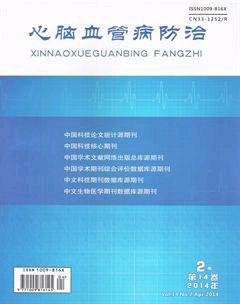甲型H1N1流感患者心肌损害的研究
张天奇等
[摘 要] 目的 探讨甲型H1N1流感患者心脏损害的特点。方法 回顾性研究分析2009年7月至2010年1月期间确诊为甲型H1N1流感患者172例的临床资料,所有患者根据病情分为轻症组,重症组,危重症组,并收集非甲型H1N1流感患者21例作为对照。大部分患者接受分子生物学检测磷酸肌酸激酶,磷酸肌酸激酶同工酶,高敏C反应蛋白,并接受胸部X线摄片检查,计算心胸比。结果 甲型H1N1流感多发生于青壮年患者,轻症患者较重症患者更年轻(P<005)。在危重症患者中,磷酸肌酸激酶,磷酸肌酸激酶同工酶,高敏C反应蛋白和心胸比均较其他组高(P<005或P<001)。1例死于心肌损害。结论 与既往研究相符,2009甲型H1N1流感可以导致心肌损害,特别是在危重症患者中心肌损害较显著,从而将导致心脏扩大等损害,导致死亡率升高。
[关键词] 甲型H1N1流感;心肌损害;高敏C反应蛋白
中图分类号:R5422 文献标识码:A 文章编号:1009_816X(2014)02_0135_02
doi:103969/jissn1009_816x20140218 甲型H1N1流感可合并心肌损害,甚至心力衰竭等[1]。已有报道[2]病毒性心肌炎可导致扩张型心肌病(DCM),心功能严重受损,甚至死亡。也有报道[3]流感病毒可诱发急性心肌梗死(AMI)和心源性猝死。本文探讨甲型H1N1流感心肌损害患者的各种临床表现以及诊治情况。
1 资料和方法
11 一般资料:回顾性分析2009年7月1日至2010年1月31日就诊于浙江大学医学院附属第一医院并确诊为甲型H1N1流感的患者172例的临床资料。患者一般表现为流感样症状(体温≥378℃,伴有咳嗽或咽痛等症状),经甲型H1N1流感病毒核酸检查(real_time PCR)确诊[4]。根据患者的病情严重程度分为轻症、重症、危重症三组[5]。(1)危重症:体温≥38℃,持续超过三天,剧烈咳嗽,咳浓痰、血痰,或胸痛,呼吸困难、急促,口唇紫绀,神志改变:反应迟钝、嗜睡、躁动、惊厥等,严重呕吐、腹泻,出现脱水现象,影像学检查有肺炎征象,肌酸激酶(CK),肌酸激酶同工酶(CK_MB)等心肌酶迅速增高,原有基础疾病明显加重。(2)重症:呼吸衰竭,感染性休克,多器官功能不全,出现其他需进行监护治疗的严重临床情况。(3)轻症:没有出现上述任一表现的确诊患者。并收集甲型H1N1流感病毒核酸阴性的流感患者作为对照组。
12 方法:病例筛选阶段,详细收集确诊患者的基本信息,包括既往史、合并症、辅助检查结果以及治疗情况,并进行详细的体格检查。统计住院期间的全因死亡率。24小时内分别收集患者静脉血,由院内检验科统一用酶偶联法检测CK,免疫化学方法检测CK_MB,免疫比浊发检测高敏C反应蛋白(hs_CRP)[6]。检查X线胸片并计算心胸比(CTR),但除外妊娠患者。
13 统计学处理:使用SPSS 160版统计软件,计量资料以(x -±s)表示,多组间比较采用方差分析,两组间比较采用LSD和Bonferroni检验,率的比较采用了卡方检验。P<005为差异具有统计学意义。
2 结果
21 一般临床资料比较:确诊的甲型H1N1流感患者172例中轻症患者46例,重症患者104例,危重症患者22例。重症组年龄比轻症组高,差异具有统计学意义(P<005),见表1。
22 CK,CK_MB,Hs_CRP及CTR结果比较:从心肌酶的结果来看,甲型H1N1病毒感染对重症及危重症患者的心肌损害可能较重。同时炎症反应在重症及危重症患者中较严重,特别是危重症组。因此,甲型H1N1流感病毒感染可能会心脏扩大,特别是危重症感染患者。
3 讨论
本文回顾性探讨了甲型H1N1流感患者心肌损害情况。从临床特点,心肌损害指标等方面进行分析,并深入探讨心血管并发症及相关死亡的发生情况。本文的研究结果发现,在这些患者中,心肌损害的临床表现并不典型,因此需要借助于实验室等辅助检查来辨析。在急性期,危重症、重症患者中间,血浆CK,CK_MB,hs_CRP和CTR均显著高于其他组患者,提示在这些患者中,可能有潜在的心肌损害,需要提高警惕。在4例死亡的患者中,有1例患者死于心肌损害。既往的研究也曾发现急性流感病毒感染可以导致心肌损害或者使原有心脏疾病的恶化[1]。因此,流感患者血浆CK,CK_MB,hs_CRP水平升高,或者CTR增加都有可能提示心肌损害,这也将有助于鉴别这些流感患者病情是否进一步恶化。
一些流行病学研究也发现流感病毒可能会导致心肌炎[7]。而在这些患者中,心脏的大小与hs_CRP的升高有关,也就是这种炎症反应状态可能与其发病直接相关,由此提出了“炎症风暴”学说[4]。在疾病早期就可以发现hs_CRP的升高,因此在流感大爆发期间早期对其干预将有助于心肌炎的早期防治。这些研究再次证明,在流感爆发期间,需要积极关注心肌损害的潜在可能,以及早防治。
本文以及既往的研究提示,在流感患者中间,CK,CK_MB,hs_CRP和CTR的升高可能早于心肌损害的临床表现的出现,因此,在这些患者中间,早期进行胸片、血浆CK,CK_MB和hs_CRP的检查将有助于早期发现心肌损害[8]。而且这些检查方便、易行。
总之,本文研究发现2009年甲型H1N1流感重症、危重症患者中存在心肌损害,早期进行分子生物学检测以及胸片检查将有助于发现早期的心肌损害,从而减少心源性疾病以及导致的病情恶化甚至死亡。
参考文献
[1]Mamas A, Doug F, Ludwig N. Cardiovascular manifestations associated with influenza virus infection[J]. Inter J Cardiol,2008,130(3):304-309.
[2]Richardson P, McKenna W, Bristow M, et al. Report of the 1995World Health Organization/International Society and Federation of Cardiology Task Force on the Definition and Classification of Cardiomyopathies[J]. Circulation,1996,93(8):841-842.
[3]Warren_Gash C, Smeeth L, Hayward AC. Influenza as a trigger for acute myocardial infarction or death from cardiovascular disease: a systematic review [J]. Lancet Infect Dis,2009,9(10):601-610.
[4]Gao HN, Lu HZ, Cao B, et al. Clinical findings in 111 cases of influenza A (H7N9) virus infection[J]. N Engl J Med,2013,368(24):2277-2285.
[5]Domínguez_Cherit G, Lapinsky SE, Macias AE, et al. Critically Ill patients with 2009 influenza A (H1N1) in Mexico[J]. JAMA,2009,302(17):1880-1887.
[6]Pearson TA, Mensah GA, Alexander RW, et al. Markers of inflammation and cardiovascular disease application to clinical and public health practice A Statement for healthcare professionals from the centers for disease. Control and Prevention and the American Heart Association[J]. Circulation,2003,107(3):499-511.
[7]Onitsuka H, Imamura T, Miyamoto N, et al. Clinical manifestation of influenza a myocarditis during the influenza epidemic of winter 1998_1999[J]. J Cardiol,2001,37(6):315-323.
[2]Richardson P, McKenna W, Bristow M, et al. Report of the 1995World Health Organization/International Society and Federation of Cardiology Task Force on the Definition and Classification of Cardiomyopathies[J]. Circulation,1996,93(8):841-842.
[3]Warren_Gash C, Smeeth L, Hayward AC. Influenza as a trigger for acute myocardial infarction or death from cardiovascular disease: a systematic review [J]. Lancet Infect Dis,2009,9(10):601-610.
[4]Gao HN, Lu HZ, Cao B, et al. Clinical findings in 111 cases of influenza A (H7N9) virus infection[J]. N Engl J Med,2013,368(24):2277-2285.
[5]Domínguez_Cherit G, Lapinsky SE, Macias AE, et al. Critically Ill patients with 2009 influenza A (H1N1) in Mexico[J]. JAMA,2009,302(17):1880-1887.
[6]Pearson TA, Mensah GA, Alexander RW, et al. Markers of inflammation and cardiovascular disease application to clinical and public health practice A Statement for healthcare professionals from the centers for disease. Control and Prevention and the American Heart Association[J]. Circulation,2003,107(3):499-511.
[7]Onitsuka H, Imamura T, Miyamoto N, et al. Clinical manifestation of influenza a myocarditis during the influenza epidemic of winter 1998_1999[J]. J Cardiol,2001,37(6):315-323.
[2]Richardson P, McKenna W, Bristow M, et al. Report of the 1995World Health Organization/International Society and Federation of Cardiology Task Force on the Definition and Classification of Cardiomyopathies[J]. Circulation,1996,93(8):841-842.
[3]Warren_Gash C, Smeeth L, Hayward AC. Influenza as a trigger for acute myocardial infarction or death from cardiovascular disease: a systematic review [J]. Lancet Infect Dis,2009,9(10):601-610.
[4]Gao HN, Lu HZ, Cao B, et al. Clinical findings in 111 cases of influenza A (H7N9) virus infection[J]. N Engl J Med,2013,368(24):2277-2285.
[5]Domínguez_Cherit G, Lapinsky SE, Macias AE, et al. Critically Ill patients with 2009 influenza A (H1N1) in Mexico[J]. JAMA,2009,302(17):1880-1887.
[6]Pearson TA, Mensah GA, Alexander RW, et al. Markers of inflammation and cardiovascular disease application to clinical and public health practice A Statement for healthcare professionals from the centers for disease. Control and Prevention and the American Heart Association[J]. Circulation,2003,107(3):499-511.
[7]Onitsuka H, Imamura T, Miyamoto N, et al. Clinical manifestation of influenza a myocarditis during the influenza epidemic of winter 1998_1999[J]. J Cardiol,2001,37(6):315-323.

